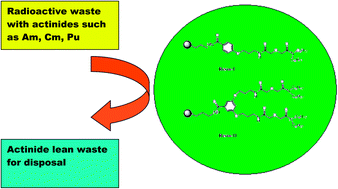First example of diglycolamide-grafted resins: synthesis, characterization, and actinide uptake studies
Abstract
Two diglycolamide (DGA)-functionalized chelating extraction resins were prepared for the first time by grafting onto a silica matrix and were evaluated for their actinide ion uptake behavior. The resins with one and two DGA moieties, termed as resin-I and resin-II, were quite efficient for the actinide ions, particularly the tri- and the tetravalent ions in a way similar to the diglycolamide extractants. The hexavalent UO22+ ion was poorly sorbed onto the resins. The resins were characterized by thermal analysis, while the surface area and surface morphology were analyzed by BET and SEM techniques. Resin-II showed a pre-concentration factor of >100 for Am(III) by elution with 0.01 M EDTA.


 Please wait while we load your content...
Please wait while we load your content...